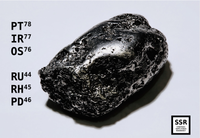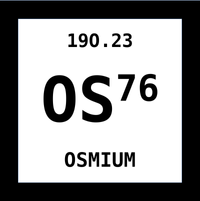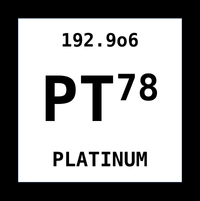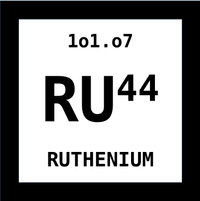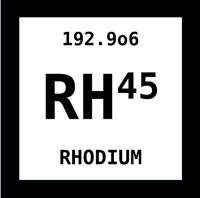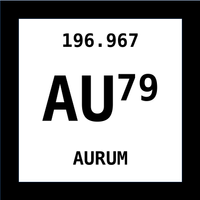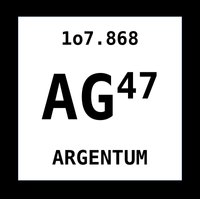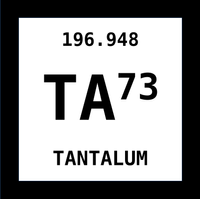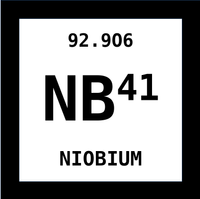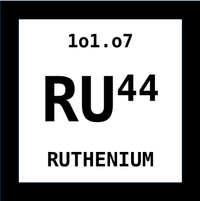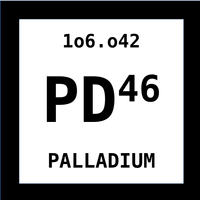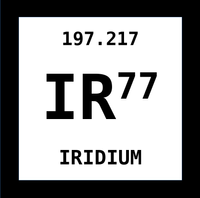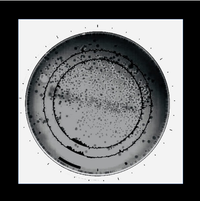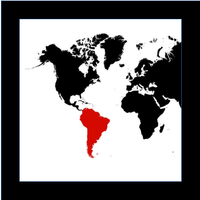PLATINUM METAL GROUP
Platinum group, six metals, in order of increasing atomic weight, ruthenium (Ru), rhodium (Rh), palladium (Pd), osmium (Os), iridium (Ir), and platinum (Pt). The elements all possess a silvery white colour - except osmium, which is bluish white. The chemical behaviour of these metals is paradoxical in that they are highly resistant to attack by most chemical reagents yet, employed as catalysts, readily accelerate or control the rate of many oxidation, reduction, and hydrogenation reactions. Ruthenium and osmium crystallize in the hexagonal close-packed system, and the others have face-centred cubic structures. This is reflected in the greater hardness of ruthenium and osmium.
Iridium is hard and brittle, but it becomes ductile and can be worked at a white heat, from 1,200° to 1,500° C (2,200° to 2,700° F). Its name is derived from the Greek ιρις (rainbow) and reflects the various colours of its salts. Like platinum, it is a white metal, though with a glint of yellow. It is one of the densest terrestrial substances. In the massive state the metal is practically insoluble in acids and is not attacked even by aqua regia.
Platinum, one of the most abundant platinum metals, and its alloys are indispensable in the chemical laboratory for electrodes and for crucibles and dishes in which materials can be heated to high temperatures. Platinum is used for electrical contacts and sparking points because it resists both the high temperatures and chemical attack of electric arcs. Jewelry and dental alloys account for much of its use; platinum-iridium is used for surgical pins.A very heavy, precious, silver-white metal, platinum is soft and ductile and has a high melting point and good resistance to corrosion and chemical attack.
PALLADIUM (Pd)
Palladium (Pd),the least dense and lowest-melting of the platinum metals, used especially as a catalyst (a substance that speeds up chemical reactions without changing their products) and in alloys. Palladium is extremely ductile and easily worked. Palladium is not tarnished by the atmosphere at ordinary temperatures. Thus, the metal and its alloys serve as substitutes for platinum in jewelry and in electrical contacts; the beaten leaf is used for decorative purposes. Relatively small amounts of palladium alloyed with gold yield the best white gold. Palladium is used also in dental alloys.
RUTHENIUM (Ru)
Ruthenium (Ru), one of the platinum metals of Groups 8–10, used as an alloying agent to harden platinum and palladium.Ruthenium has a low crustal abundance of about 0.001 part per million. Elemental ruthenium occurs in native alloys of iridium and osmium, along with the other platinum metals: up to 14.1 percent in iridosmine and 18.3 percent in siserskite. It also occurs in sulfide and other ores in very small quantities that are commercially recovered.
RHODIUM (Rh)
Rhodium is a silvery white, shiny metal. It does not tarnish in air. Outstanding resistance to corrosion, endowed with high light-reflecting power makes it is one of the strongest metals mechanically. Predominantly used as an alloying agent to harden platinum. Rhodium is a precious metal, with a high reflectivity for light. Used to give permanent, attractive surfaces for jewelry.
HISTORY OF PLATINUM METAL GROUP
Although platinum-containing gold artifacts have been dated as far back as 700 BCE, the presence of this metal is more likely adventitious than deliberate. References to gray, dense pebbles associated with alluvial gold deposits were made by Jesuits in the 16th century. These pebbles could not be melted alone but would alloy with and adulterate gold to the extent that the gold bars would become brittle and impossible to refine. The pebbles became known as platina del Pinto - that is, granules of silvery material from the Pinto River, a tributary of the San Juan River in the Chocó region of Colombia.
The fashioning of platinum into fine jewelry began about 1900, but, while this application remains important even today, it was soon eclipsed by industrial uses. Palladium became a very desirable material for contact points in the relays of telephone and other wire communications systems, where it provided long life and a high level of reliability, and platinum, because of its resistance to spark erosion, was incorporated into spark plugs for combat aircraft during World War II.
After the war the expansion of molecular conversion techniques in the refining of petroleum created a great demand for the catalytic properties of the platinum metals. This demand grew even more in the 1970s, when automotive emission standards in the United States and other countries led to the use of platinum metals in the catalytic conversion of exhaust gases.
ORES
With the exception of small alluvial deposits of platinum, palladium, and iridosmine (an alloy of iridium and osmium), virtually no ores exist in which the major metal is from the platinum group. Platinum minerals are usually highly disseminated in sulfide ores, particularly the nickel mineral pentlandite, (Ni,Fe)9S8. The most common platinum-group minerals include laurite, RuS2; irarsite, (Ir,Ru,Rh,Pt)AsS; osmiridium, (Ir,Os); cooperite, (PtS); and braggite, (Pt,Pd)S.
The world’s largest deposit is the Bushveld Complex of South Africa. Other major deposits include the Sudbury deposit of Ontario, Canada, and the Norilsk-Talnakh deposit of Siberia in Russia. Within the United States the largest deposit is the Stillwater Complex in Montana, but this is substantially smaller than the deposits cited above. The world’s largest producers of platinum are South Africa, Russia, Zimbabwe, and Canada.
MINING & CONCENTRATING
The major South African and Canadian deposits are exploited by underground mining. Virtually all platinum-group metals are recovered from copper or nickel sulfide minerals, which are concentrated by flotation separation. Smelting of the concentrate produces a matte that is leached of copper and nickel sulfides in an autoclave. The solid leach residue contains 15 to 20 percent platinum-group metals.
Sometimes gravity separation is employed prior to flotation; this results in a concentrate containing up to 50 percent platinum metals, making smelting unnecessary.
EXTRACTION & REFINING
The separation chemistry of the platinum-group metals is among the most complex and challenging of metal separations. A brief description of procedures for isolating the platinum-group metals is set forth below, followed by descriptions of assaying and scrap-refining techniques.
INDIVIDUAL SOLUBILIZATION
The classical procedure for separating the platinum metals begins with a mineral concentrate obtained as described above. This concentrate is leached with aqua regia, which dissolves the platinum and palladium and leaves the other metals as solids in the leach residue. The platinum is precipitated from solution with ammonium chloride, and the resulting crude platinum salt is recovered by filtration and then heated to decompose it to a powdered metallic form.
The metal is redissolved in aqua regia, then reprecipitated with ammonium chloride and calcined to pure metal. The palladium, which remained in solution when the platinum was precipitated, is now precipitated by the addition of ammonia. After the palladium salts are recovered by filtration, they are redissolved and reprecipitated to form a pure salt, and this is converted to metallic form, usually by chemical reduction with formic acid.
The residue left over from leaching the original mineral concentrate contains rhodium, iridium, ruthenium, and osmium. This is treated with molten sodium bisulfate to convert the rhodium to rhodium sulfate. The rhodium is then solubilized by water leaching, separated from the insolubles, and precipitated from solution by reduction with zinc powder.
The crude rhodium metal product is converted to a soluble salt by treatment with chlorine and sodium chloride at high temperature, dissolved in water, precipitated with sodium nitrite, filtered, redissolved, and reprecipitated with ammonium chloride. This final precipitate is reduced to a pure metal powder.
The residue from rhodium sulfate leaching is fused with alkali nitrate salts to convert ruthenium to soluble sodium ruthenate. After filtration, the solution of sodium ruthenate is treated with chlorine gas to distill off the ruthenium as the volatile compound ruthenium tetroxide. The ruthenium-bearing distillate is then treated with reducing agents to precipitate the ruthenium as a fine metal powder. Osmium is recovered in a similar fashion, although, unlike ruthenium, it can also be recovered by distillation from acidic solutions.
The final residue is treated with sodium peroxide to convert iridium to a form soluble in hydrochloric acid, from which it can be precipitated with ammonium chloride and calcined to metal powder.
SIMULTANEOUS SOLUBILIZATION
Simultaneous solubilization of all platinum metals can be accomplished by fusing the mineral concentrate obtained from copper and nickel sulfide ores with aluminum metal, dissolving the aluminum, and treating the residue with hydrochloric acid and chlorine. This dissolves all platinum-group metals, which are subsequently separated by solvent extraction. The individual metal solutions are then treated by conventional techniques to recover the various metals in a pure state.
CONSOLIDATION
Irrespective of the chemical separation processes used, the platinum metals are recovered in a finely divided metallic powder form. They can be converted to massive metal form by electron-beam melting. The lower-melting-point metals palladium and platinum can be fused by induction melting techniques.
REFINING FROM SCRAP
There is no universally applicable technique for reprocessing platinum-metals scrap. The chosen procedure depends on the various proportions of the platinum metals in the sample. For example, platinum or platinum-alloy scrap—such as laboratory ware, glass-furnace linings, and spinnerets used in synthetic-fibre manufacture - can be redissolved in aqua regia and recovered from solution by techniques discussed above. Alloys containing ruthenium and iridium are sometimes solubilized by alkaline fusion. Once the metal is dissolved, the process chemistry employed to recover it is similar to that discussed above.
The bulk of platinum, palladium, and rhodium scrap is found in automotive catalytic converters. The catalyst is melted at a very high temperature with iron or copper to fuse the catalyst substrate and dissolve the platinum-group metals in the molten copper or iron. The alloy of copper and precious metals is leached to dissolve the copper or iron, leaving behind a platinum-palladium-rhodium concentrate, which is refined to pure metals with chemistry similar to that described above.
ASSAYING
Assaying ores and concentrates for platinum-group metals is extremely difficult, since the concentration of any particular metal may be less than one part per million. Initial concentration is achieved by fire assay. The assay bead is dissolved in aqua regia and the metals separated and concentrated, often by solvent extraction. Dissolution of the bead is complicated by the presence of iridium, rhodium, or ruthenium, so that special solubilizing techniques may be required. The concentrated solutions are analyzed by atomic absorption spectroscopy or photometric techniques. Arc spectroscopy is sometimes employed directly on the bead obtained from fire assay.
THE METALS & THEIR ALLOYS
The mechanical properties of the six platinum metals differ greatly. Platinum and palladium are rather soft and very ductile; these metals and most of their alloys can be worked hot or cold. Rhodium is initially worked hot, but cold-working can be done later with rather frequent annealing. Iridium can be worked hot, as can ruthenium, but with difficulty; neither metal can be cold-worked appreciably.
Osmium is the hardest of the group and has the highest melting point, but its ready oxidation is a limitation. Iridium is the most corrosion-resistant of the platinum metals, while rhodium is valued for retaining its properties at high temperatures.
STRUCTURAL APPLICATIONS
Since pure annealed platinum is extremely soft, it is susceptible to scratching and marring. In order to improve hardness, it is alloyed with a variety of other elements. Platinum jewelry is very popular in Japan, where it is called hakkin, or “white gold.” Alloys for jewelry castings include 90-percent-platinum–10-percent-palladium, which is readily worked and brazed. Adding ruthenium to platinum-palladium alloys increases their hardness while maintaining their oxidation resistance. Alloys of platinum-palladium-copper are used in wrought products, since these alloys are harder than platinum-palladium alloys yet less costly.
Crucibles used for single-crystal production in the semiconductor industry require both corrosion resistance and stability at high temperature. For this application, platinum, platinum-rhodium, and iridium are the best suited. Platinum-rhodium alloys are employed in the production of thermocouples that are capable of measuring temperatures as high as 1,800 °C (3,270 °F). Palladium is used in both the pure and alloyed states for a variety of electrical applications (accounting for 50 percent of consumption) and for dental alloys (30 percent of consumption). Rhodium, ruthenium, and osmium are used rarely in the pure state but rather as alloying elements for the other platinum-group metals.
CATALYSTS
Approximately 42 percent of all platinum produced in the Western world is employed as a catalyst. Of this, 90 percent is applied to automotive exhaust systems, where refractory pellets or honeycomb structures coated with platinum (as well as palladium and rhodium) promote the conversion of unburned hydrocarbons, carbon monoxide, and nitrogen oxides into water, carbon dioxide, and nitrogen.
An alloy of platinum and 10 percent rhodium, formed into a gauze and operating at bright red heat, serves as the catalyst in the reaction between ammonia and air to produce nitrogen oxides and ultimately nitric acid. By feeding in some methane along with the ammonia mixture, hydrocyanic acid can be produced. In petroleum refining, platinum is distributed onto the surface of aluminum oxide pellets and placed into reactor vessels. There it catalyzes the reforming of long-chain naphtha molecules into branched-chain isoparaffins, which are desirable in the blending of high-octane gasoline.
ELECTROPLATING
All the platinum metals can be electroplated. Palladium is the easiest to process, and the plated metal is much harder than the wrought metal. The hardness of electrodeposited ruthenium makes it suitable for instruments where a low-pressure rubbing contact is required.
Rhodium is the most commonly electroplated of the platinum metals because of the hardness and lustre of the electrodeposit. Although the cost of rhodium is greater than that of platinum, its lower density allows the use of a lesser weight of metal to obtain a deposit of comparable thickness.
CHEMICAL COMPOUNDS
Organometallic complexes of platinum-group metals, such as alkylplatinum complexes, are employed as catalysts in olefin polymerization, the production of polypropylene and polyethylene, and the oxidation of ethylene to acetaldehyde.
Platinum salts are finding increasing use in cancer chemotherapy as drugs marketed under the generic names carboplatin and cisplatin. Ruthenium oxide-coated electrodes are employed in the production of chlorine and sodium chlorate. Rhodium sulfate and rhodium phosphate are the compounds preferred for rhodium electroplating baths.
